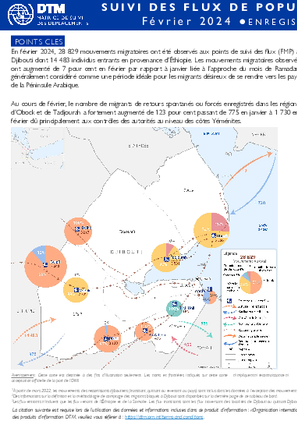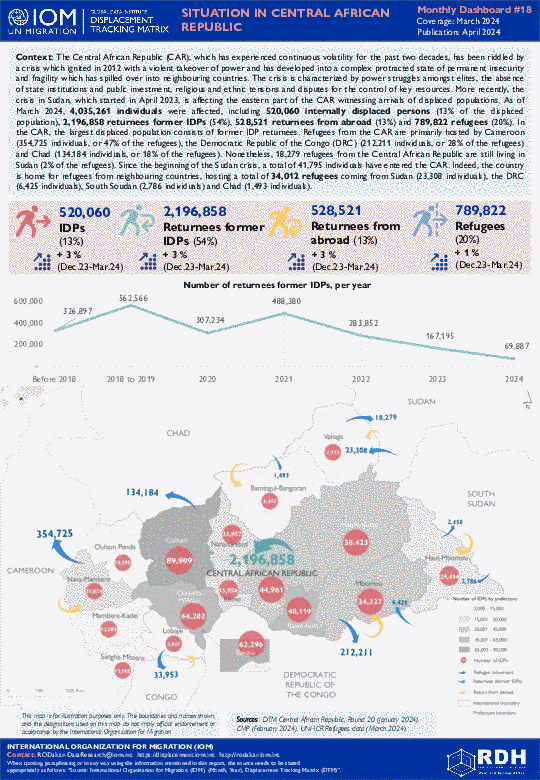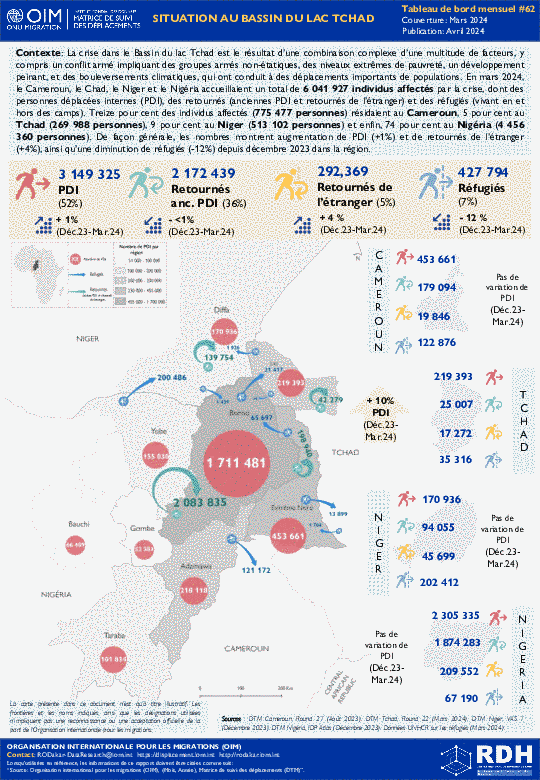-
Countries
-
Data and Analysis
-
Special Focus
-
Crisis Responses
The Central African Republic (CAR), which has experienced continuous volatility for the past two decades, has been riddled by a crisis which ignited in 2012 with a violent takeover of power and has developed into a complex protracted state of permanent insecurity and fragility which has spilled over into neighbouring countries. The crisis is characterized by power struggles amongst elites, the absence of state institutions and public investment, religious and ethnic tensions and disputes for the control of key resources. More recently, the crisis in Sudan, which started in April 2023, is affecting the eastern part of the CAR witnessing arrivals of displaced populations.
As of March 2024, 4,035,261 individuals were affected, including 520,060 internally displaced persons (13% of the displaced population), 2,196,858 returnees former IDPs (54%), 528,521 returnees from abroad (13%) and 789,822 refugees (20%). In the CAR, the largest displaced population consists of former IDP returnees. Refugees from the CAR are primarily hosted by Cameroon (354,725 individuals, or 47% of the refugees), the Democratic Republic of the Congo (DRC) (212,211 individuals, or 28% of the refugees) and Chad (134,184 individuals, or 18% of the refugees). Nonetheless, 18,279 refugees from the Central African Republic are still living in Sudan (2% of the refugees). Since the beginning of the Sudan crisis, a total of 41,795 individuals have entered the CAR. Indeed, the country is home for refugees from neighbouring countries, hosting a total of 34,012 refugees coming from Sudan (23,308 individuals), the DRC (6,425 individuals), South Soudan (2,786 individuals) and Chad (1,493 individuals).

Contact
DTM Nigeria, iomnigeriadtm@iom.int
Language
English
Location
Nigeria
Period Covered
Mar 25 2024
Mar 31 2024
Activity
- Mobility Tracking
- Event Tracking
On 27 March 2024, armed bandits attacked the community of Mutunji in Maru ward of Maru LGA in Zamfara State. There were no reports of injuries and fatalities. The attack displaced 230 individuals in 42 households to Tsunami community in Rijya ward of Gusau LGA of Zamfara State. The displaced individuals included 129 children and 101 women. The men in the community decided to stay back.
Of all the needs identified, food and shelter were the most prevalent. Other needs included security and non-food items (NFI).
Following these events, DTM (Displacement Tracking Matrix) field staff conducted rapid assessments to inform the humanitarian community and Government/partners, and to enable a targeted response.
Nigeria’s North-central and North-west zones are afflicted with a multi-dimensional crisis. Long-standing tensions between ethnic and religious groups often result in attacks and banditry or hirabah. These attacks involve kidnapping and grand larceny along major highways by criminal groups. During the past years, the crisis accelerated and has resulted in widespread displacement across the North-central and North-west regions.
The Central Sahel area, and in particular the Liptako Gourma region, which borders Burkina Faso, Mali and Niger, is affected by a complex crisis involving growing competition over dwindling resources; climatic variability; demographic pressure; high levels of poverty; disaffection and a lack of livelihood opportunities; communal tensions; the absence of state institutions and basic services; and violence related to organized crime and non-state armed groups. The crisis has triggered significant displacement of populations in the concerned countries and is affecting neighbouring countries such as Mauritania and the coastal countries.
As of March 2024, 3,046,874 individuals have been displaced, including 2,636,880 internally displaced persons (87% of the displaced population) and 409,994 refugees (13% of the displaced population). Sixty-nine per cent of the displaced populations (2,100,686 individuals) were located in Burkina Faso, while 14 per cent resided in Mali (419,534 individuals), 10 per cent in Niger (289,051 individuals) and 4 per cent in Mauritania (119,354 individuals). The crisis’ recent spill over to coastal countries, namely Côte d’Ivoire, Ghana, Togo and Benin, shows growing number of refugees coming from the Central Sahel and populations internally displaced. As of March, 118,249 individuals were affected by displacement within the four countries (18,897 in Benin, 45,900 in Côte d’Ivoire, 7,142 in Ghana and 46,310 in Togo) of which 30,372 were internally displaced.
La crise dans le Bassin du lac Tchad est le résultat d’une combinaison complexe d’une multitude de facteurs, y compris un conflit armé impliquant des groupes armés non-étatiques, des niveaux extrêmes de pauvreté, un développement peinant, et des bouleversements climatiques, qui ont conduit à des déplacements importants de populations. En mars 2024, le Cameroun, le Chad, le Niger et le Nigéria accueillaient un total de 6 041 927 individus affectés par la crise, dont des personnes déplacées internes (PDI), des retournés (anciennes PDI et retournés de l’étranger) et des réfugiés (vivant en et hors des camps). Treize pour cent des individus affectés (775 477 personnes) résidaient au Cameroun, 5 pour cent au Tchad (269 988 personnes), 9 pour cent au Niger (513 102 personnes) et enfin, 74 pour cent au Nigéria (4 456 360 personnes). De façon générale, les nombres montrent augmentation de PDI (+1%) et de retournés de l’étranger (+4%), ainsi qu’une diminution de réfugiés (-12%) depuis décembre 2023 dans la région.
The crisis currently affecting the Lake Chad Basin states results from a complex combination of factors, including conflict with non-state armed groups, extreme poverty, underdevelopment and a changing climate, which together have triggered significant displacement of populations. As of March 2024, Cameroon, Chad, Niger and Nigeria were hosting an estimated 6,041,927 affected individuals made up of internally displaced persons (IDPs), returnees (former IDPs and returnees from abroad) and refugees (both in- and out-of-camp). Thirteen per cent of the affected population (775,477 individuals) were located in Cameroon, while 5 per cent resided in Chad (296,988 individuals), 9 per cent in Niger (513,102 individuals) and finally, 74 per cent in Nigeria (4,456,360 individuals). Overall, the numbers show increases in IDPs (+1%) and returnees from abroad (+4%), and a decrease in refugees (-12%) since December 2023.
Contact
iomkyrgyzstan@iom.int
Location
Kyrgyzstan
Activity
- Mobility Tracking
Period Covered
Oct 18 2023 -Dec 22 2023
The dataset presents findings from surveys conducted in Kyrgyzstan using the International Organization for Migration's (IOM) Mobility Tracking Matrix (MTM) system. Adapted from IOM's Global Displacement Tracking Matrix (DTM) methodology, MTM aims to collect and analyze data to understand the mobility, vulnerabilities, and needs of displaced and mobile populations for evidence-based migration management. 9 regions were covered, 45 rayons were assessed, and 1,228 returned migrants were interviewed.
Population Groups
Other
Survey Methodology
Unit of Analysis Or Observation
Admin Area 2
Individual
Type of Survey or Assessment
Keywords
Geographical Scope Full Coverage
Administrative boundaries with available data
The current dataset covers the following administrative boundaries
Contact
iomkyrgyzstan@iom.int
Location
Kyrgyzstan
Activity
- Mobility Tracking
Period Covered
Jun 26 2023 -Aug 17 2023
The dataset presents findings from key informant interviews conducted in Kyrgyzstan using the International Organization for Migration's (IOM) Mobility Tracking Matrix (MTM) system. Adapted from IOM's Global Displacement Tracking Matrix (DTM) methodology, MTM aims to collect and analyze data to understand the mobility, vulnerabilities, and needs of displaced and mobile populations for evidence-based migration management. 9 regions were covered, 45 rayons were assessed, and 48,130 individuals were identified as having returned from abroad.
Population Groups
Migrants Present
Other
Survey Methodology
Unit of Analysis Or Observation
Admin Area 2
Admin Area 3
Other
Type of Survey or Assessment
Key Informant
Keywords
Geographical Scope Full Coverage
Administrative boundaries with available data
The current dataset covers the following administrative boundaries
Contact
DTMUKRAINE@IOM.INT
Location
Ukraine
Activity
- Mobility Tracking
Period Covered
Feb 01 2024 -Feb 29 2024
IOM's Data and Analytics (D&A) Unit developed the Mobility and Needs Assessment (MaNA), a monthly, multi-sectoral assessment designed to systematically monitor the estimated current presence of key population groups, including de facto Internally Displaced Persons (IDPs), returnees and non-displaced residents, at the hromada level. MaNA also offers a regular baseline for evaluating population needs at a granular level, with a specific focus on hard-to-reach areas. It utilizes sector specific indicators, serving as a compass to steer humanitarian programming and response efforts.
This report presents the primary findings from the sixth round of MaNA, conducted in February 2024 across 255 hromadas located in 23 oblasts and Kyiv City. Assessed hromadas were selected based on their relevance to humanitarian programming, pre-war population size, and known displacement trends.
This is a restricted dataset. To get access, kindly click on the 'Request Access' button.
Population Groups
IDPs
Residents
Returnee (Previously Internally Displaced)
Survey Methodology
Unit of Analysis Or Observation
Admin Area 2
Admin Area 3
Site or Location
Type of Survey or Assessment
Key Informant
Keywords
Geographical Scope Partial Coverage
Administrative boundaries with available data
The current dataset covers the following administrative boundaries
Contact
IOMKABULDTMALLUSERS@iom.int
Location
Afghanistan
Activity
- Mobility Tracking
- Site Assessment
Period Covered
Jan 25 2024 -Feb 29 2024
IOM Afghanistan launched the first round of the DTM Baseline Area Assessment B1 in January 2024 as part of its ongoing efforts to collect crucial data on population mobility dynamics, specifically displacement and returns. In particular, the B1 activity seeks to map the presence of mobile population groups, such as Internally Displaced Persons (IDPs), returnees, and internal migrants, to enable further understanding of conditions, vulnerabilities, and humanitarian needs through targeted data collection and analysis.
The community-level dataset is available based on request only, to get access kindly click on the 'Request Access' button.
Population Groups
IDPs
Returnee (Previously Displaced Abroad)
Returnee (Previously Internally Displaced)
Survey Methodology
Unit of Analysis Or Observation
Admin Area 2
Site or Location
Type of Survey or Assessment
Key Informant
Keywords
Geographical Scope Partial Coverage
Administrative boundaries with available data
The current dataset covers the following administrative boundaries

Contact
DTM Djibouti, DTMDjibouti@iom.int
Language
English
Location
Djibouti
Period Covered
Feb 01 2024
Feb 29 2024
Activity
- Flow Monitoring
En février 2024, 28 829 mouvements migratoires ont été observés aux points de suivi des flux (FMP) à Djibouti dont 14 483 individus entrants en provenance d’Éthiopie. Les mouvements migratoires observés ont augmenté de 7 pour cent en février par rapport à janvier liée à l’approche du mois de Ramadan généralement considéré comme une période idéale pour les migrants désireux de se rendre vers les pays
de la Péninsule Arabique.
Au cours de février, le nombre de migrants de retours spontanés ou forcés enregistrés dans les régions d’Obock et de Tadjourah a fortement augmenté de 123 pour cent passant de 775 en janvier à 1 730 en février dû principalement aux contrôles des autorités au niveau des côtes Yéménites.



